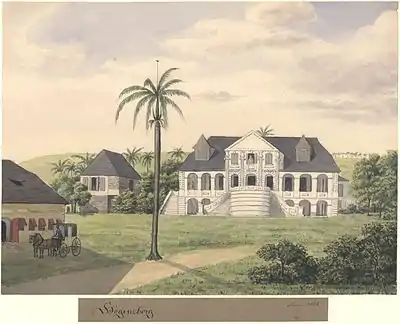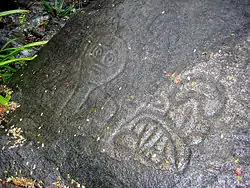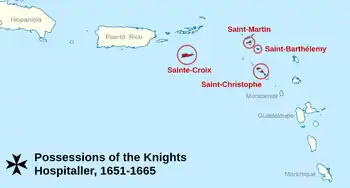History of the United States Virgin Islands
The United States Virgin Islands, often abbreviated USVI, is a group of islands and cays in the Caribbean to the east of Puerto Rico. Consisting of three larger islands (Saint Croix, Saint John, and Saint Thomas) plus fifty smaller islets and cays, it covers approximately 133 square miles (340 km2). Like many of its Caribbean neighbors, its history includes native Amerindian cultures, European exploration followed by subsequent colonization and exploitation, and the enslavement of Africans.[1]
The United States Virgin Islands are located in the Lesser Antilles of the Eastern Caribbean (between the Atlantic Ocean and Caribbean Sea), the United States Virgin Islands are actually approximately 50 islands and cays (pronounced "keys"), the largest of which are St. Croix, St. Thomas and St. John, respectively.[2]
Population
Virgin Islander Americans include people born there, plus immigrants from the British Virgin Islands, and their descendants. It also includes migrants from the U.S. Virgin Islands to the U.S. mainland. American citizenship was conferred in 1927, and U.S. citizens moving between the Virgin Island and the rest of the U.S can do so without the need for a passport.[3]
The population of the United States Virgin Islands forms a complex society with multiple diverse ethnic groups: Virgin Islanders, Eastern Caribbean Islanders, Puerto Ricans, Dominicans (Dominican Republic), French, Americans (locally known as "continentals"), Arabs and Asians. At least one writer feels the ethnic cultural practices and institutions that remain, migration, and the influence of the mainland United States have made the society more pluralistic than given it any common Virgin Islands identity.[4]
Early inhabitants of the Virgin Islands included the Ciboney, Arawaks, and Island Caribs. The first documented Europeans to visit the islands arrived with Christopher Columbus. Groups of settlers from various European nations arrived on the islands over the next century, including Britain, the Dutch Republic, France, and Denmark.[5] In 1733, the Danish West India Company purchased Saint Croix from France and brought together Saint Thomas, Saint Croix, and Saint John as the Danish West Indies. Danish trading posts were set up on the islands, trading in sugar, slaves and other goods. Sugar cane cultivation was a major economic activity for many years, with slaves used as one of the labor sources. However, following increasing humanitarian awareness, laws against slavery and a slave rebellion in 1848, the governor Peter von Scholten officially freed the last slaves the same year. The islands were purchased from the Danish by the United States in 1917 under the Treaty of the Danish West Indies. The goal was to protect access to the Panama Canal in wartime.
Early history
The Guanahatabey
Although not much is known about the Guanahatabey people who inhabited the islands during the Stone Age, archaeological evidence seems to indicate that they were hunter-gatherers. They made tools of stone and flint but left few other artifacts behind.
The Arawaks
Experts at canoe building and seamanship, the Arawaks migrated from the Amazon River Valley and Orinoco regions of Venezuela and Brazil, settling on the islands near coasts and rivers. These peaceful people excelled at fishing and farming. They grew cotton, tobacco, maize, yuca, and guava as well as a variety of other fruits and vegetables.
The Arawaks developed intricate social and cultural lives. For recreation, they held organized sporting events. They also valued artistic endeavors, such as cave painting and rock carving, some of which have survived to the present. Religion played a large role in their daily lives, and through ceremonial rituals they asked their gods for advice to help them through troubled times. Their civilization flourished for several hundred years until the Caribs invaded.
Caribs
While the Caribs came from the same area as the Arawaks and may have been distantly related, they did not share the Arawaks' friendly nature. Not only were they fierce warriors, they supposedly feasted on their adversaries. Their bloodthirsty reputation spawned the English word cannibal, derived from the name the Spanish gave them, Caribal.
Whether or not they actually ate their victims, the Caribs did destroy numerous Arawak villages. By the mid-15th century, the Caribs had slashed the Arawak population from several million to a few thousand. But even the Caribs were no match for the Europeans who came.
Spanish and French colonial period
Blown off course during his 1493–1496 voyage, Christopher Columbus landed on Saint Croix, then continued his explorations on Saint Thomas and Saint John. He gave the islands their original Spanish names (Santa Cruz, San Tomas, and San Juan), focusing on religious themes. The collection of tiny islets, cays, and rocks dotting the sea around them reminded Columbus of Saint Ursula and her 11,000 virgin martyrs, inspiring the name Las Once Mil Virgenes.
The first encounter Columbus had with the Caribs quickly erupted into a battle. When Columbus and his crew decided to move on to other islands, they kidnapped six Arawaks to guide them. Although Columbus left without founding a colony, many more battles between the Spanish and Caribs followed over the next century.
The French and Danish colonizers finished the job the Spanish had begun. They tried to convert the Caribs and Arawaks to Catholicism and Lutheranism, which largely failed. They also enslaved the native populations to work on plantations. With tobacco having already been cultivated on the islands, it made a good cash crop. Later on, coffee, sugar, and cotton also were grown.
The Danish West Indies period

Diseases, coupled with murder and slavery, took a large toll on both the Arawaks and the Caribs. Several groups of Arawaks committed mass suicide rather than submit to foreign rule. By the late 17th century, the Arawaks had vanished and few Caribs remained. The Virgin Islands were raided by Spanish from Puerto Rico seeking slaves.
With only a small population on the islands, there was a great demand for labor. The trans-Atlantic slave trade to the islands began in 1673. The difficult conditions and inhumane treatment slaves were subjected to bred discontent. Moravian Brethren missionaries from Herrnhut Saxony, arrived in St. Thomas in December 1732. Distrusted by the slave holders, they lived with the slaves and won their confidence.
In 1733 a long drought followed by a devastating hurricane pushed slaves in St. John to the breaking point. Members of the Akwamu tribe from modern Ghana staged a massive rebellion, seizing control of the island for six months. The Danes, who controlled the island at that point, enlisted the help of French authorities from Martinique to regain control (see St. John Slave Revolt).
A non-violent slave revolt in 1848 proved more successful. The governor at the time, Peter von Scholten, faced with thousands of enslaved Africans with burning torches threatening to burn down the town of Frederiksted, freed the slaves, even though the Danish Crown had so far intended that the last slaves would be emancipated in 1859. Von Scholten would later be summoned before a commission of enquiry for his action and deprived of his pension but he was eventually exonerated by the Supreme Court.
 The Danish hospital building located at Estate Little Princess on St. Croix in the Christiansted region
The Danish hospital building located at Estate Little Princess on St. Croix in the Christiansted region Charlotte Amalie circa 1874
Charlotte Amalie circa 1874 A sugar mill in Saint Croix before 1900
A sugar mill in Saint Croix before 1900 A sugar plantation in Saint Croix before 1900
A sugar plantation in Saint Croix before 1900 Danish colonial building in Charlotte Amalie, now a storefront near Market Square
Danish colonial building in Charlotte Amalie, now a storefront near Market Square
American rule
The United States' first secretary in London, Henry White attempted to purchase the islands from Denmark in 1899 to resist European incursions into the Americas. The sale was unsuccessful and White attributed the failure to the influence of Kaiser Wilhelm II of the ascendent German Empire.[6] During World War I, the fear of rising German interest in the Caribbean prompted the President Woodrow Wilson to assert the Roosevelt Corollary in Haiti and the Dominican Republic.
In 1917 a treaty was concluded in which the United States purchased the islands for $25,000,000 (about $390,000,000 in 2010 dollars). After the United States bought what is now known as the United States Virgin Islands from the Danish, the islands officially became an unincorporated U.S. territory in 1927. Most residents were granted U.S. citizenship in 1936, and an act of 1932 provided that all natives of the Virgin Islands who on the date of the act were residing in the continental United States or any of its insular possessions or territories were U.S. citizens. The islands remained under the direct control of the U.S. government until 1968, when residents were first allowed to elect their own governor (previously, governors had been appointed first by the navy, then by the interior department). In 1972, residents elected their first non-voting delegate to Congress.
Knowing of his interest in graphic design, Rear Admiral Kitten ordered a yeoman, Percival Wilson Sparks, who was married to St. Thomas native, Grace Itah Maria Joseph Sparks, to design a new flag for the territory. Sparks designed the flag and had his wife and her sister, Blanche Joseph Sasso, sew the first flag for the U.S.V.I. as the professionally made flags had to be manufactured in the States and would take weeks to arrive by ship. The sisters from St. Thomas were then known as the Betsy Rosses of the Virgin Islands.
The 1930s represented a watershed as the economy reversed itself because of two external stimuli: The repeal of prohibition in the U.S., which greatly increased the demand for plantation workers, and the wartime decision to construct a submarine base on St. Thomas. Because of habitual out-migration to the U.S. and the historical absence of a peasant agricultural tradition, the indigenous labor supply was inadequate. This vacuum created the demand for West Indian labor from the Eastern Caribbean for the first of several immigrant waves.[7]
The Organic Act of the Virgin Islands of the United States of 1936 (Pub.L. 74–749, 49 Stat. 1807, enacted June 22, 1936) established a local government, replacing previous temporary provisions (Pub.L. 64–389, 39 Stat. 1132, enacted March 3, 1917).
The Virgin Islands government set a new policy of export diversification via tourism and light industry. People continued to immigrate in substantial numbers — some legally and others illegally. They benefited from a series of loose interpretations and favorable revisions of immigration law which reduced occupational restrictions and generally lax enforcement.[7]
In 1954, the Revised Organic Act of the Virgin Islands repealed and replaced the previous Organic Act.
 March 31, 1917, after 251 years of Danish colonial rule, Dannebrog is lowered for the last time at the Guvonners mansion at Saint Croix
March 31, 1917, after 251 years of Danish colonial rule, Dannebrog is lowered for the last time at the Guvonners mansion at Saint Croix_(14780439341).jpg.webp) 1917 money transfer after the Treaty of the Danish West Indies
1917 money transfer after the Treaty of the Danish West Indies_(14596880870).jpg.webp) $25,000,000 receipt for the Treaty of the Danish West Indies
$25,000,000 receipt for the Treaty of the Danish West Indies 1937 U.S. stamp showing Charlotte Amalie
1937 U.S. stamp showing Charlotte Amalie Sugar farmers in the vicinity of Bethlehem, Saint Croix, United States Virgin Islands, December 1941
Sugar farmers in the vicinity of Bethlehem, Saint Croix, United States Virgin Islands, December 1941 Company Street, Christiansted's main shopping street, December 1944.
Company Street, Christiansted's main shopping street, December 1944.
References
- "Virgin Islands History". 2019 Guide to the US Virgin Islands. Retrieved October 25, 2019.
- Paris Permenterand John Bigley. "US Virgin Islands." in Romantic Escapes in the Caribbean (Hunter Publishing, 2001), p. 342+. online
- Allman-Baldwin, L. (2002). United States Virgin Islands, Part 1. New York Amsterdam News, 93(37), 28.
- Ockerstrom, Lolly. "Virgin Islander Americans." Gale Encyclopedia of Multicultural America, edited by Thomas Riggs, (3rd ed., vol. 4, Gale, 2014), pp. 513-522. online
- Roopnarine, Lomarsh. Social Identity in the Modern Virgin Islands. College of Liberal Arts and Social Sciences, University of the Virgin Islands, St. Croix, US Virgin Islands.
- Isaac Dookhan, A History of the Virgin Islands of the U.S. (2nd ed. Kingston, Jamaica: Canoe Press, 1994).
- Moskin, J. Robert (2013). American Statecraft - The Story of the U.S. Foreign Service. New York, New York: St. Martin's Press.
- Klaus de Albuquerque and Jerome L. McElroy, "West Indian Migration to the United States Virgin Islands: Demographic Impacts and Socioeconomic Consequences" International Migration Review 16#1 (1982), pp. 61–101
External links
- "Scholten and the emancipation of Danish Slaves in the Danish West Indies"
- Virgin Islands Humanities Council
- St. John Historical Society
- Danish West Indies History
- The Danish West-Indies, a primary source search portal maintained by the Danish National Archives.

